Article written by Elisa
This article may contain compensated links. Please read disclaimer for more info.
France is one of the world’s top cheese consumers, consuming more than 20kg of cheese per year /inhabitant! The country produces more than 300 different types of cheese, many of which are AOC or AOP (Appellation d’Origine Contrôlée – Protégée).
In France, cheeses are usually eaten after the main course and before the dessert. Another way to enjoy local specialties is on a plate with different cheese varieties during an apéritif.
During your next trip to France, get ready to savor as many cheeses as possible! But since time is limited and there’s only so much your stomach can handle, here are the 10 best French cheeses you need to try (grouped by region), their characteristics, and how to enjoy them.
Table of Contents:
Famous Cheeses in France
1. Bleu d’Auvergne
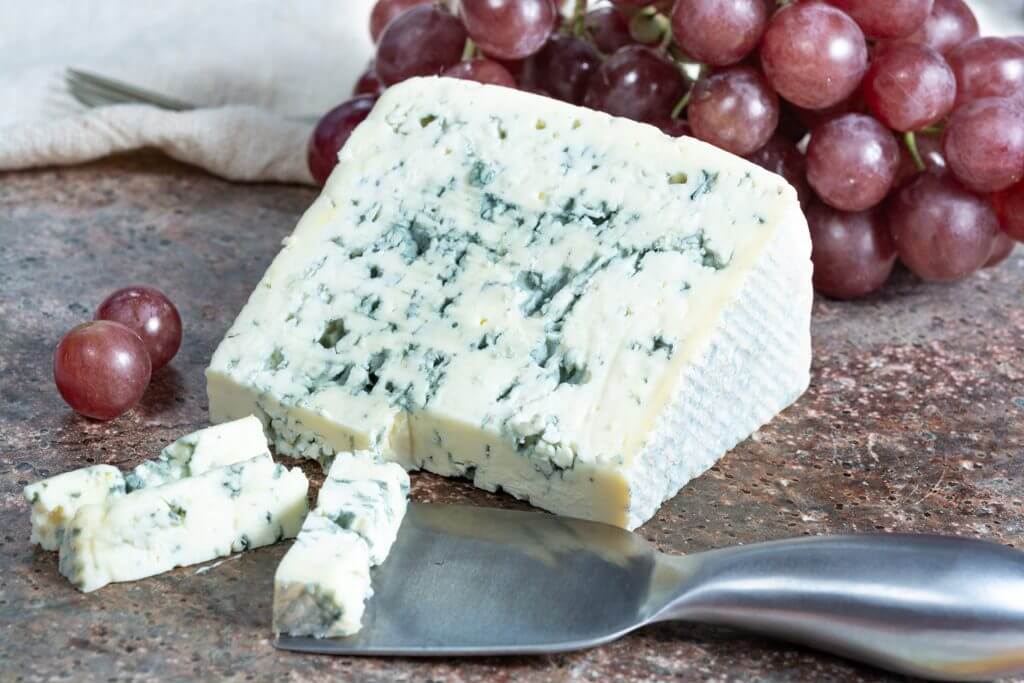
The most famous cheese from Auvergne is the Bleu d’Auvergne. This cheese is characterized by the iconic blue veins from which it takes its name.
The Bleu d’Auvergne is a “pâte persillée, non cuite” cheese, which means that it is a pressed and uncooked cheese. This making process gives it a nice, creamy texture.
Made with cow milk, it does have a pungent smell and a spicy but fresh tang.
Great on its own, the Bleu d’Auvergne has a distinct flavor, but it is milder than similar blue cheeses, which is why it is also perfect for dishes. I love bleu cheeses, and the Bleu d’Auvergne is amongst my favorites!
2. Saint-Marcellin
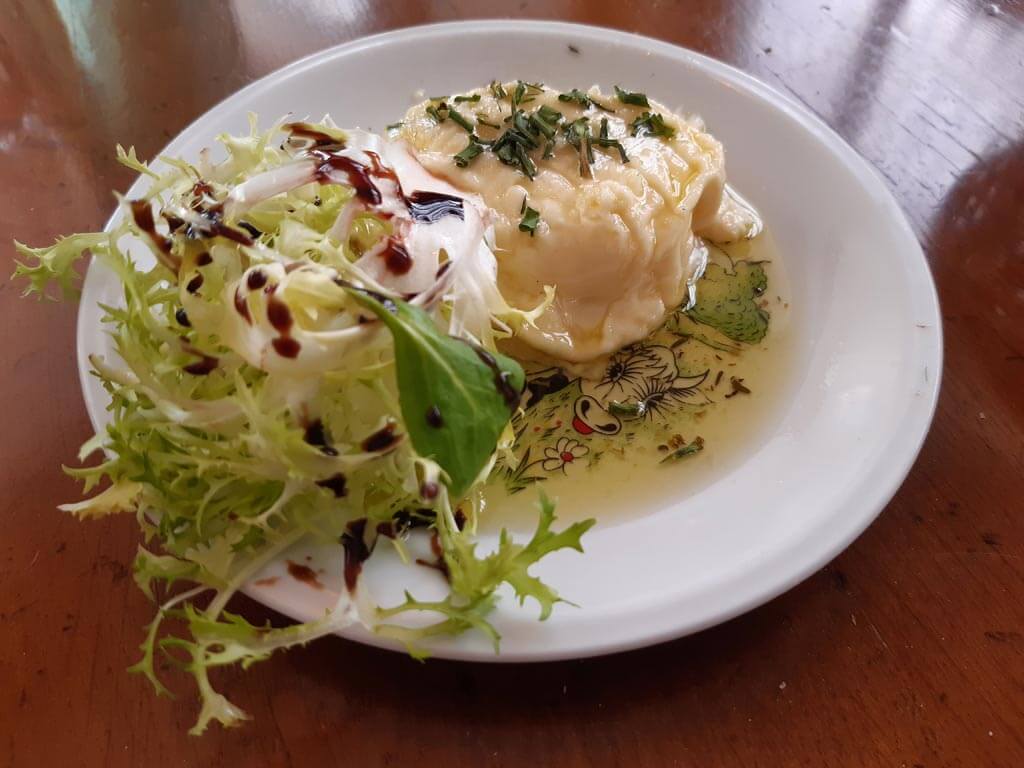
Saint-Marcellin is a “pâte molle” (soft) cheese named after the namesake small town located in the Rhône-Alpes region.
Made with cow’s milk and dusted with white yeast, it’s hard to resist its creamy look!
This soft cheese has three types of ripening: sec, crémeux, and bleu. Saint-Marcellin has a mild and salty taste with a nutty and fruity undertone.
It is perfect to be eaten as it is, served on a cheese board, or smeared on a baguette. This is how you will find it served in the traditional menu of bouchons Lyonnais. Another way to eat the Saint-Marcellin cheese is to heat it, which makes it all nice and gooey.
Although I prefer it raw, I ordered this warm Saint-Marcellin in the picture as an entrée in a restaurant in Lyon, and I found it delicious!
3. Cantal
This “pâte persillée, non cuite” cheese (pressed, uncooked) is from the town of Cantal, in the Auvergne-Rhône-Alpes region.
It is made with cow’s milk, and the Cantal wheel can reach 45kg! It also has two different appellations, Salers and Laguiole.
Cantal cheese has three varieties, depending on how long it has aged. The Cantal jeune (young) has aged 1- 2 months, the Cantal entre-deux or Cantal doré has aged 3- 9 months, and the Cantal vieux (old) has aged more than 8 months. This cheese’s smell and taste increase with age, and many people say Cantal cheese is quite close to an English farmhouse cheddar.
4. Reblochon
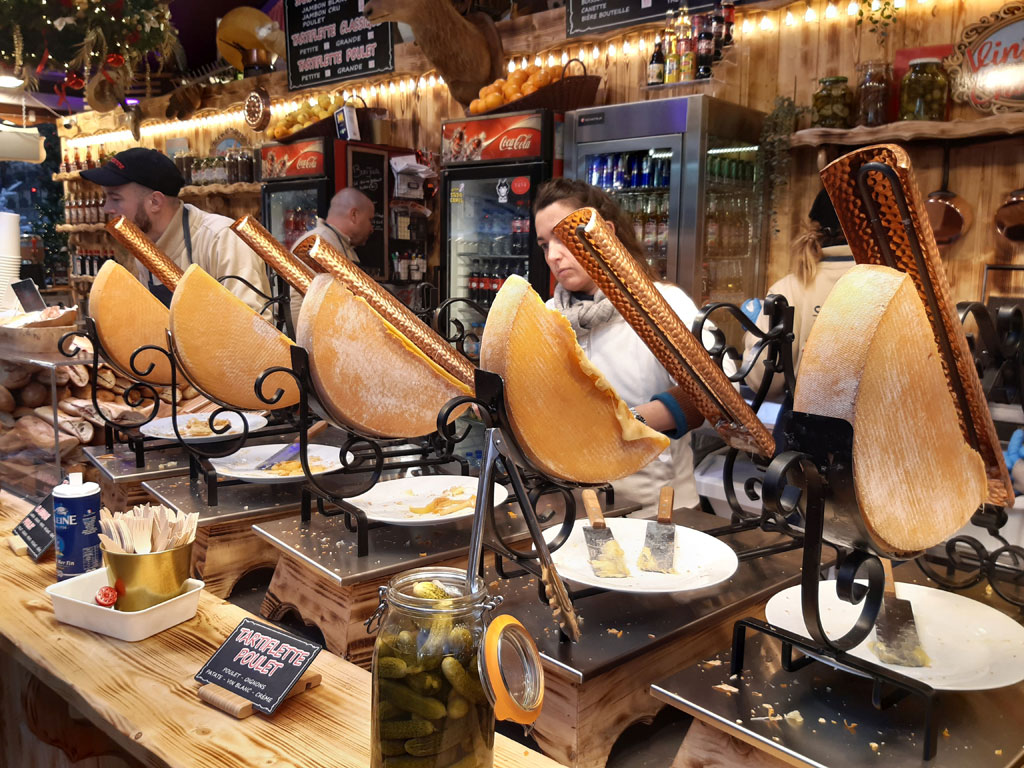
Reblochon is a raw cow’s milk cheese from the French Alps, specifically from the Savoie department, and it smells really bad!
Reblochon is a soft and washed-rind cheese that is periodically cured in mold-bearing agents, making its odor particularly pungent.
This unpasteurized cheese also has a distinctive flavor, and it is used to make “tartiflette,” a delicious dish usually found in the Christmas Markets in France with potatoes, lardons, and onions, all topped with Reblochon.
Reblochon is banned in the US, so make sure to taste it during your trip to France! To be honest, I have never tried because I can’t stand its smell, lol.
5. Mont d’Or

Made in the Franche-Comté region, the Mont d’Or cheese is also known as Vacherin du Haut-Doubs cheese, distinguishing it from the Swiss type.
This washed-rind, soft cheese is made with raw cow’s milk and is a rare product, available only from September to May (it wouldn’t resist warmer temperatures).
It has a yellowish exterior and a gooey and creamy texture. Don’t let its funky smell stop you from trying it: Mont d’Or flavor is delicious! It is typically served warm, with it being baked in the oven, and you can enjoy it plain, scooping it directly from the cocotte.
6. Comté
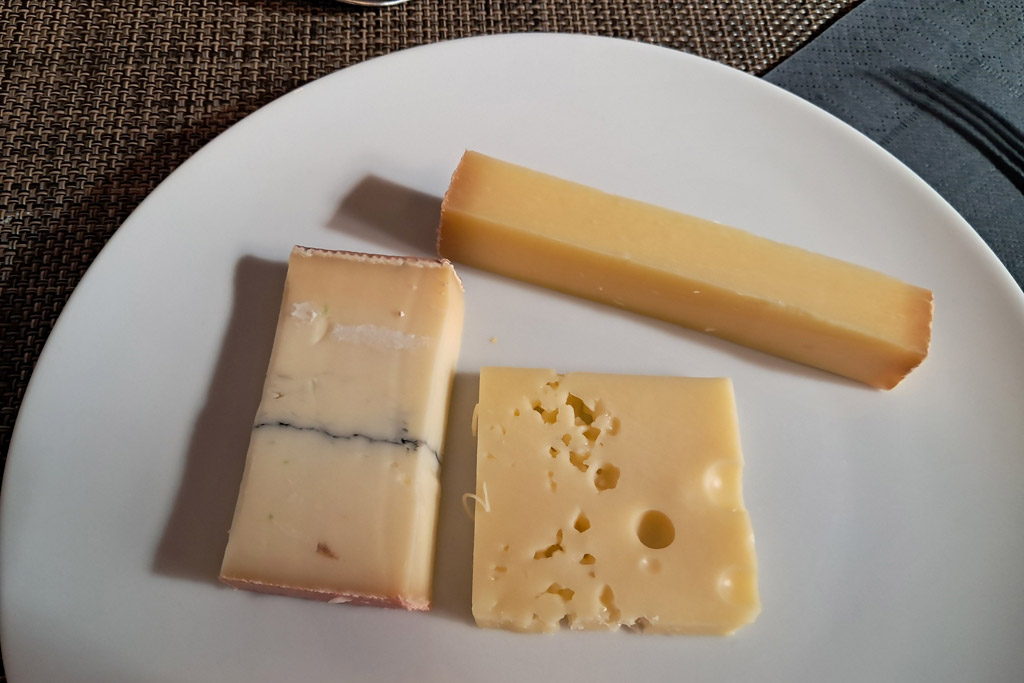
Comté is one of the most popular cheeses in France, and it also comes from the Franche-Comté region.
A hard cheese made with cow’s milk, Comté is mild and slightly sweet, with a complex, fruity, and nutty flavor. It is classified as an Alpine cheese.
Aged between 4 and 24 months, it develops protein crystals as it ages, providing a unique texture.
You will always find Comté on French cheese boards, but it is also a perfect addition to sandwiches or grated over soups. This is the kind of cheese that you can always find in my fridge in the wintertime.
7. Crotin de Chavignol
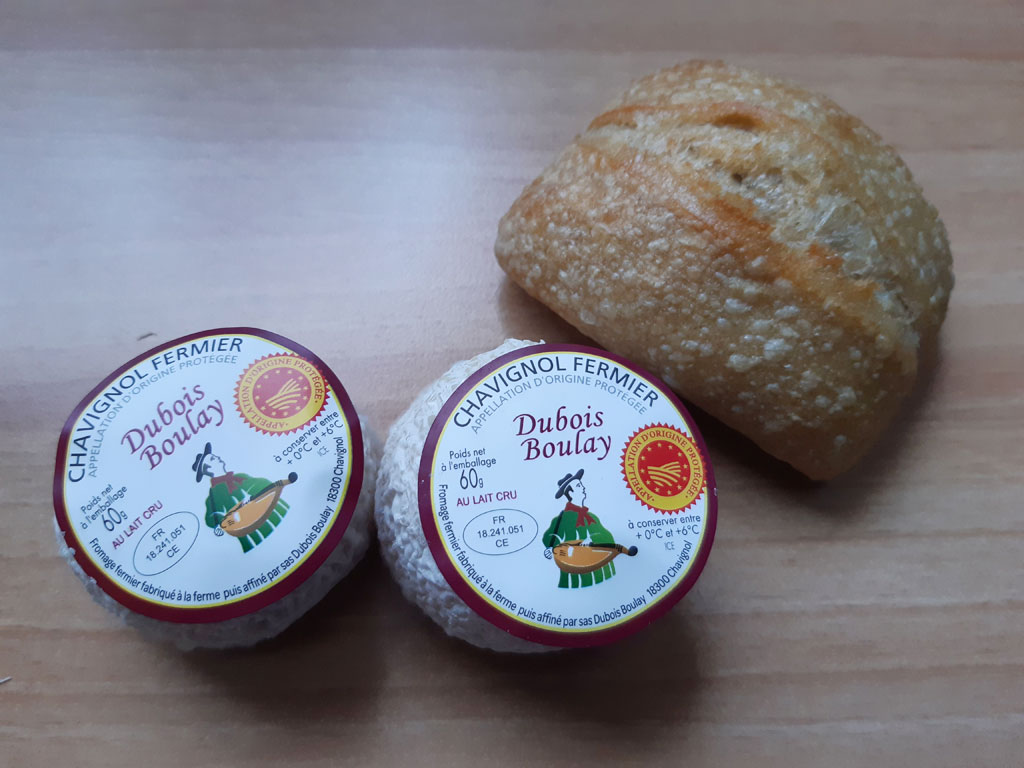
Another incredibly popular French cheese is Crotin de Chavignol. It is produced in the Loire Valley and made with goat milk.
Small, soft-ripened, and crumbly, this cheese is not pasteurized. It has a minimum aging time of 4 weeks and three stages of maturity. Depending on its age, the cheese’s texture changes from solid to crumbly, and its smell gets stronger.
Crotin de Chavignol’s flavor is subtle and slightly nutty. It is most commonly eaten baked or crumbled over a green salad or as a component of a cheese board selection.
8. Selles-sur-Cher

This cheese from the Loir-et-Cher department, in the Loire Valley, is made with goat milk.
Selles-sur-Cher is a soft, unaged cheese with a grey-blue mold surface. Its flavor is tangy and lightly salty, with a persistent aftertaste.
Some people eat it without removing the moldy exterior for a stronger experience. However, its texture is to die for: moist and softening as it melts in the mouth. As it is with other moldy cheeses, it has a pretty pungent smell.
Selles-sur-Cher is ideal to enjoy during an apéritif or in a salad. I especially like it with a glass of white wine from the Touraine region.
9. Munster
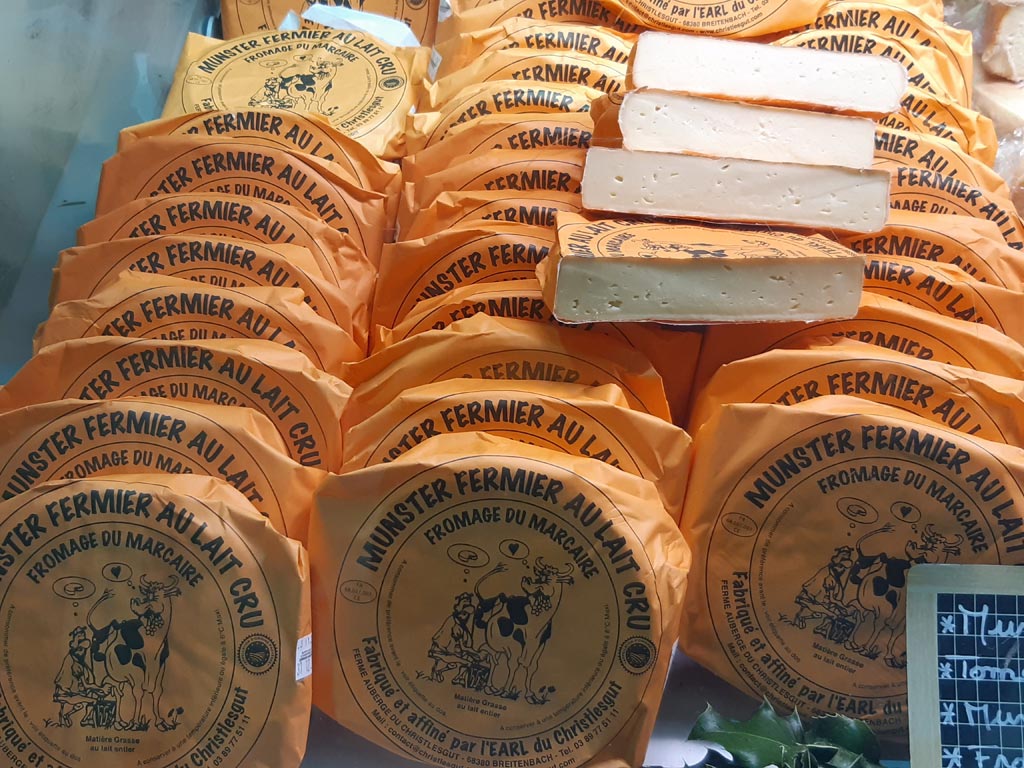
This soft cheese with washed rind from the Alsace region is made with raw cow’s milk. Originally aged in monk cellars, Munster has a minimum maturing period of 21 days.
This cheese has a strong smell but a slightly more gentle aroma on the palate.
Munster is best enjoyed by itself after the meal and before the dessert. This cheese is also used to make tartiflettes in Alsace, also called ‘munsteriflettes,’ which you will find in all the Alsace Christmas Markets. Another dish where you can taste Munster in Alsace is burgers, and it is ideally paired with Alsatian white wines.
10. Maroilles

Maroilles is one of the oldest cheeses in France. It has been known since the 10th century and was the favorite cheese of several French kings.
This soft, washed-rind cheese is made with cow milk and is produced in the Hauts-de-France region.
Maroilles is one of the strongest French cheeses, with a particularly pungent aroma and a distinct orange-red exterior. I really like it, but only in small portions. Its smell is not for the faint-hearted!
Its earthy flavors make Maroilles a staple on the menus of bistros and brasseries in Lille. Pair Maroilles with French cider or sweet white wine for a great end to your meal!
11. Brie de Meaux
One of the most popular cheeses in France, Brie is beloved worldwide. It’s a soft cow’s milk cheese with a moldy crust from Meaux in the Ile-de-France region. It matures for 4-8 weeks and comes in many varieties, including truffles.
Its velvety texture and buttery flavor make Brie just fabulous to eat on its own or spread on a baguette. You can also find it served at room temperature and paired with a green apple or baked and warm for a comforting treat.
Being from Ile-de-France, I feel I should be promoting it more here, but it’s just not my kind of cheese.
12. Camembert

This world-famous French cheese was first produced in the late 18th century in the town of Camembert, in the Normandy region.
Slightly similar to Brie, Camembert is a soft cheese made from raw cow milk from Norman cows that live in the open air day and night. It has a crust with mold, and it has at least a 3-week aging period.
Creamier and more pungent than Brie, Camembert has earthy notes that recall mushrooms and hazelnuts. It is usually cut into triangles and served with nuts or fruit, like grapes.
In Normandy, it is common to find Camembert au Four (baked Camembert) on the menus. I prefer the raw version.
13. Pont l’Evêque
Another soft cheese with a washed rind from the Normandy region, Pont l’Evêque is square and made with cow’s milk. Its origin dates back to the 12th century, and it seems Cistercian monks first made it.
Pont l’Evêque has a smooth texture and a pungent smell, but it has a subtle and sweet flavor. This cheese comes both pasteurized and unpasteurized, and its aging period is 4-6 weeks.
Pont l’Evêque is quite popular in France but mainly unknown to tourists, so you really should try it on your French trip!
14. Ossau-Iraty
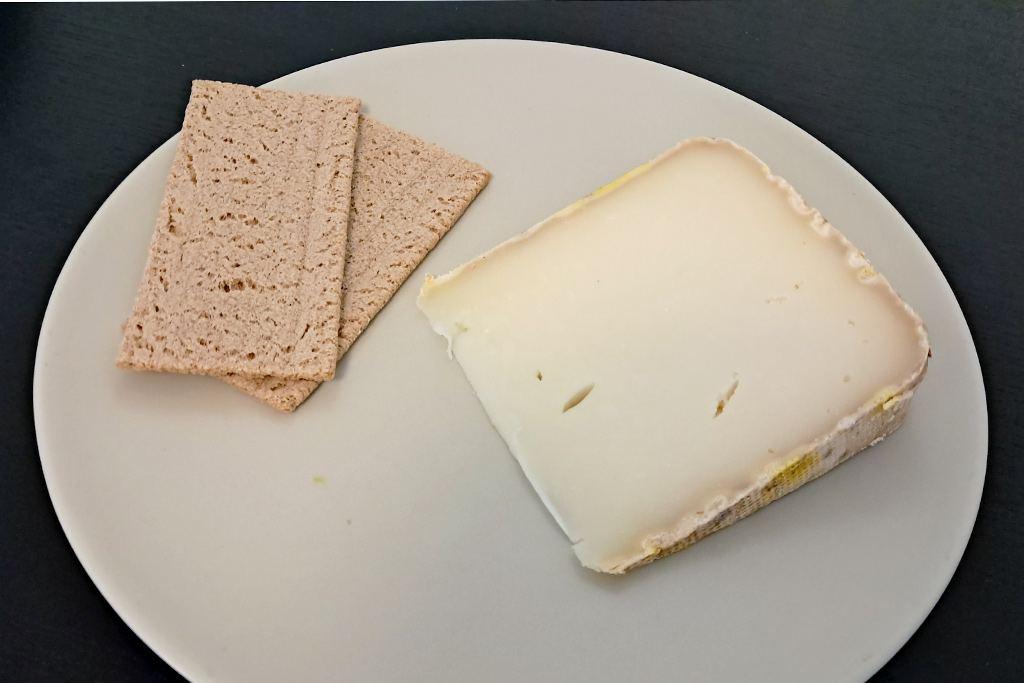
Ossau-Iraty is a pressed, uncooked cheese made with raw sheep’s milk, produced in the French Basque Country /Ossau Valley, in the Nouvelle-Aquitaine region.
It is still made using ancient techniques and matured for at least two months. It has a rich flavor with herbal and nutty undertones.
Ossau-Iraty comes in the form of tommes, and it is usually eaten at room temperature, sliced into cold cuts, as ingredients in sandwiches, or grated into soups. Ossau-Iraty is my favorite cheese for breakfast, so I enjoy a piece almost every day!
15. Roquefort
This is my personal favorite, a characteristic blu-veined cheese from a small town called Roquefort, in the Occitanie region. It is made from sheep milk, not pasteurized, and it has a 5-month aging period.
Often called the “King of Cheeses” due to its popularity amongst royalty throughout history, Roquefort has a very pungent scent and a bold, slightly bitter flavor.
Without a rind, it has a moist texture and is delicious on its own, as part of a cheese board, or paired with fresh fruits like figs and pears. It is also often used to make sauces, tarts, and quiches.
How to Cut French Cheese
There’s a proper way to cut French cheese – and yes, it matters! Especially if you’re with French people (you don’t want to shock them) or having breakfast in a French hotel, where cheese is often shared.
The key rule to cut cheese in France: everyone should get an equal share, so how you cut the cheese depends entirely on its shape. So please, be mindful and cut the French cheese properly, at least when you are in France 😉
So, what’s the correct way to cut different types of cheese? Here’s a helpful diagram to use as a guide!
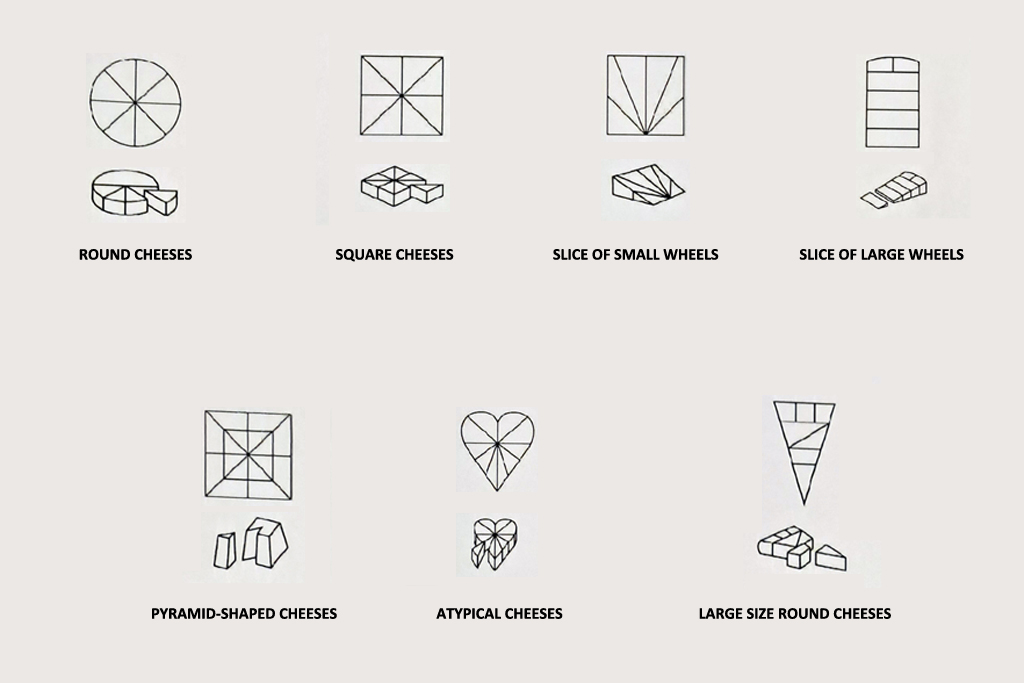
Round Cheeses (Camembert, Munster): cut these cheeses like you would cut a pie, into triangle-shaped portions.
Square Cheeses (Pont l’Éveque, Maroilles): cut these cheeses like a cake, starting with a diagonal cut, which creates two triangles. Then, cut each triangle in half, and so on, to create equal parts.
Slice of Small Wheels (Mimolette, Roquefort): lay the cheese flat. Slice a wedge from the center of the thin edge to equally spaced points along the thick edge.
Slice of Large Wheels (Comté, Beaufort): Start on the core end by cutting long slices parallel to the rind. Then, at about mid cheese, you cut perpendicular to the rind.
Pyramid-Shaped Cheeses (Valençay, Pouligny): Cut it as if it were a round cheese, all the way through the height of the cheese, in thin portions.
Atypical Cheeses (Neufchâtel): Cut it as if it were a round cheese, intersecting the middle in even-wedged, triangular slices. Luckily, there are not many French cheeses shaped like this!
Large Size Round Cheeses (Brie): Cut the nose off. Then, cut another diagonal slice and a perpendicular one at the end of the rind, so each slice will have a bit of rind on it.
How to Prepare a Plate of Cheese in France
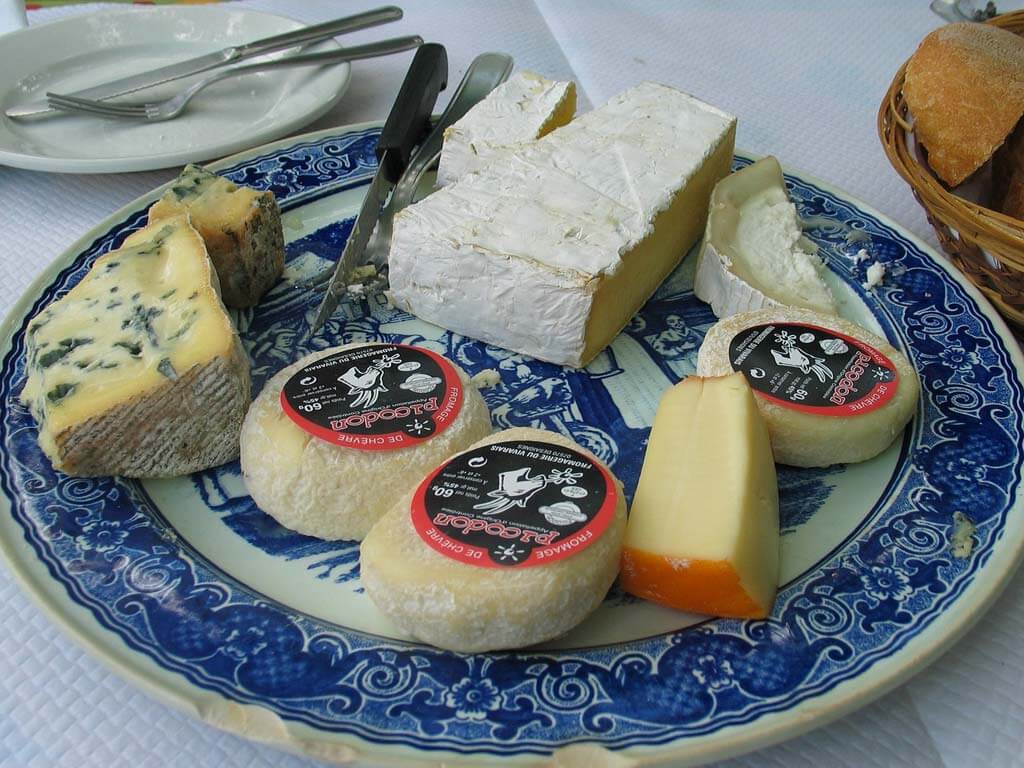
A skill to learn is how to prepare a perfect plate of French cheeses to serve your guests at home.
A “traditional” French cheese platter usually includes a goat cheese, a blue cheese (a “bleue”), a soft cheese, a hard cheese, and a fresh cheese. Depending on where you are in France, the cheeses will be different (they’re usually regional), but this structure is a common rule of thumb.
Cheeses are enjoyed with baguette slices or country bread.
